
 |
Please write: dan@dancooper.tv
Return to Page One
Register here to receive Fashion Finds
email updates!
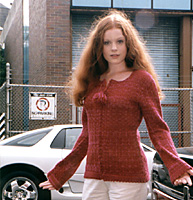 |
 |
Brooklyn Handknit is located at:
149 North 6th Street
Brooklyn, NY (Williamsburg)
718.782.5919
Remnants of woolen fabrics have been found in archeological sites from Babylon, Egypt, to Peru. The Romans introduced weaving to the ancient Britains, who already had a tradition of sheep herding. The sophistication and beauty of these archeological remnants are stunning.
Wool is lush, sensuous, beautiful, versatile and practical. It lasts forever. It has a wonderful tactile quality. The scent of it, when you bury your head into a sweater or blanket, and breathe in the wool’s fragrances, is homey, comforting and unique.
Janis Stemmermann, the designer / owner of Brooklyn Handknit, carries on the ancient tradition of the knitting, crocheting, and sculpting of wool. Her styles are sleek, without losing any of their handknit quality; innovative, engaging, and whimsical. Her use of color is stupendous – rich, rich rainbows of color!
Janis started out as a sculptor and printmaker, but
she has been knitting since childhood. We chatted with her about how she got started, how
her designs evolved, and her store and workshop in Williamsburg – a neighborhood in
Brooklyn.
 |
FF: You’ve mentioned to me that you often carve forms, and it’s usually from a block of wood.
Janis Stemmermann: Well, I went through a period where I decided to start making forms or sculptures. And I would start from a piece of a tree, whether it is six inches in diameter, or twenty inches. And I was interested in it as a whole piece. And then I would begin working. The shapes aren’t very complex. They’re actually very simple. They’re sort of very horn-shaped, with an internal space and then the outer shape.
In the making of these pieces I sort of go back to certain periods of my life. For instance, I realized it sort of came from when my father died. We, as a family, had been building a log cabin in New Hampshire from scratch. And my mother decided the next summer that she would take us – my brother and my sisters -- back to New Hampshire, and finish the log cabin on our own.
For her, it was the way of sort of trying to shield herself, and try to make sense of this loss. But it was very proactive in trying to feel like you had the power to do something.
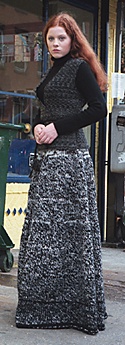 |
And I realized that fact when I gathered the tools, and wanted to begin sculpting, that these were all the tools that we used in making this log cabin. And what I realized was, I was sort of going back to this experience that I had, and taking it further, and making sense of it in a new way.
There’s this very raw side to it. But then, I’ve always been very interested in textile, in pattern, and how those two, form and pattern, go together. And that goes into the knitting.
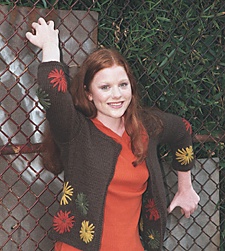 |
FF: And what do you think it is about yarn and knitting that’s so interesting to you?
Janis Stemmermann: Well yarn, it’s the wool particularly, is just a great fiber. It’s just fantastic. Because wool has such a life to it, where it comes from, and it’s as a fiber that there’s nothing that compares to it. Because it has a life to it, and it’s just like it can expand, contract, and you know it just does all kinds of things. It’s just an ideal fiber. I mean I suppose a lot of people are very sensitive to it, but it does a lot of things. It’s pretty amazing.
I’ve always been attracted to wool, and I actually have a harder time with other kinds of fibers, which I’m trying to incorporate in what I do, just because there’s such a demand for blends and whatever. But I really do love wool as a fiber. And how it knits. For hand knitting it’s ideal.
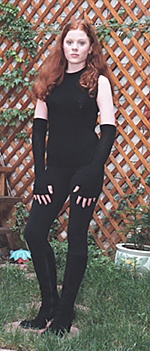 |
FF: What are the other fibers that are in demand?
Janis Stemmermann: People think that especially in hand knits that they want cotton.
FF: That stretches so much.
Janis Stemmermann: But cotton really isn’t a good knitting fiber. It’s better for crocheting. I don’t like to knit with cotton at all. So I find the best kinds of things are like wool blends with acrylic. Because acrylic actually knits closest to wool. People sort of shudder when they hear the word acrylic. But it’s not a bad fiber to knit with, if it’s a really good acrylic.
Not one other complete fiber is ideal for knitting. But it’s usually if it’s a blend, it works better.
FF: And those mohair shawl wraps, is mohair like wool?
Janis Stemmermann: That hair comes from an Angora goat. It’s different -- it’s a longer fiber.
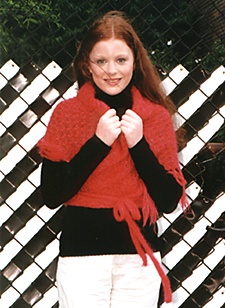 |
Janis Stemmermann: The wrap shawl is actually knit on a hand loom. Because it’s the lace mohair, lace mohair onto machine.
FF: Oh so you do use a hand loom as well.
Janis Stemmermann: Yes. Out of necessity.
FF: Because you have to produce a lot, right?
Janis Stemmermann: And hand knitting is a very excessive thing to produce. And also the quality control is much more difficult, because everyone knits differently.
FF: True.
Janis Stemmermann: And you really have to work with each knitter individually, and work with how they knit. Whereas a machine is easier, especially when you get into larger pieces, because you can control that better.
Next, how to care for your woolens, and more beautiful designs from Brooklyn Handknit....
ABC Carpet & Home
Bergdorf Goodman
Henri Bendel
Searle
Big Drop
Calypso
Me & Ro
Patricia Field
TG-170
Visit
Brooklyn Handknit's web site:
Click here